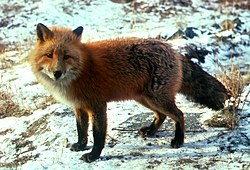| Subspecies | Trinomial authority | Description | Range | Synonyms |
|---|
British Columbian fox
Vulpes fulva abietorum  | Merriam, 1900 | Generally similar to V. f. alascensis, but with a lighter, longer and more slender skull. [13] | The interior of British Columbia and probably southeastern Alaska, U.S. | sitkaensis (Brass, 1911) |
Northern Alaskan fox
Vulpes fulva alascensis  | Merriam, 1900 | A large, long-tailed, small-eared subspecies with golden-fulvous fur. [13] | The Andreafsky Wilderness, Alaska, U.S. | harrimani Merriam, 1900
kenaiensis Merriam, 1900 |
Cascade Mountains red fox
Vulpes fulva cascadensis  | Merriam, 1900 | A short-tailed, small-toothed subspecies with yellow rather than fulvous fur; it is the subspecies most likely to produce "cross" color morphs. [13] | The Cascade Mountains, Skamania County, Washington, U.S. | |
Eastern American red fox
Vulpes fulva fulva  | Desmarest, 1820 | A small subspecies, with a smaller, sharper face, a shorter tail, a lighter pelt more profusely mixed with whitish and darker limbs. [13] | Eastern Canada and the eastern U.S. | pennsylvanicus (Rhoads, 1894) |
Wasatch Mountains fox
Vulpes fulva macroura  | Baird, 1852 | Similar to V. f. fulva, but with a much longer tail, larger hind feet, and more extensive blackening of the limbs. [13] | Named for the Wasatch Mountains near the Great Salt Lake, Utah; found in the Rocky Mountains from Colorado and Utah, western Wyoming and Montana through Idaho north to southern Alberta | |
Sierra Nevada red fox or High Sierra fox
Vulpes fulva necator  | Merriam, 1900 | Externally similar to V. f. fulva; it has a short tail, but cranially it is more like V. f. macroura. [13] | The High Sierra, California | |
Sacramento Valley red fox
Vulpes fulva patwin | Sacks et al, 2010 [14] | Externally similar to V. f. fulva; it has a short tail, but cranially it is more like V. f. macroura. [13] | The Sacramento Valley, California | |
Northern plains fox
Vulpes fulva regalis  | Merriam, 1900 | The largest North American red fox subspecies; it has very large and broad ears and a very long tail. It is a golden-yellow color with pure black feet. [13] | The Elk River, Sherburne County, Minnesota, U.S. | |
Nova Scotia fox
Vulpes fulva rubricosa | Bangs, 1898 | A large subspecies with a large, broad tail and larger teeth and rostrum than V. f. fulva; it is the deepest-colored subspecies. [13] | Digby County, Nova Scotia, Canada | bangsi (Merriam, 1900)
deletrix (Bangs, 1898)
rubricos (Churcher, 1960)
vafra (Bangs, 1897) |










